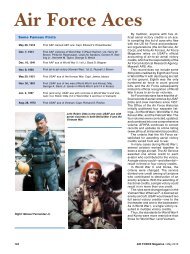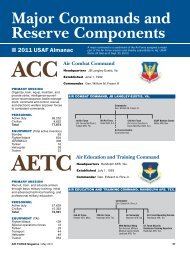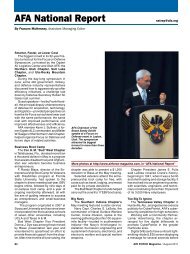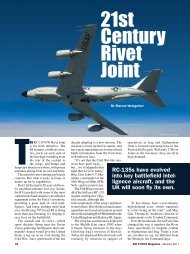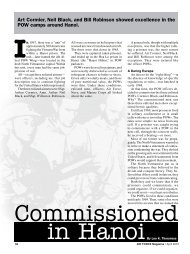1997 Annual Defense Report Table of Contents - Air Force Magazine
1997 Annual Defense Report Table of Contents - Air Force Magazine
1997 Annual Defense Report Table of Contents - Air Force Magazine
Create successful ePaper yourself
Turn your PDF publications into a flip-book with our unique Google optimized e-Paper software.
Child Development Program<br />
Today, over 65 percent <strong>of</strong> military spouses are in the labor force, an increase <strong>of</strong> 11 percent over the last<br />
seven years. DoD standard child care programs and common dependent education curriculum in the<br />
Department <strong>of</strong> <strong>Defense</strong> Education Activity schools provide unique stability and continuity for military<br />
family members. Military families need 299,000 spaces for children from birth through age 12. The<br />
Department is meeting about 54 percent <strong>of</strong> the need for care in military child development programs with<br />
162,500 spaces at 300 locations. These include spaces in 9,810 family child care homes and 831 child<br />
development centers and school-age care located in youth facilities, schools, and other community<br />
support facilities. DoD's short-term goal is to meet 65 percent <strong>of</strong> the need -- a goal the Department is<br />
projected to reach in FY <strong>1997</strong>. Much <strong>of</strong> the growth has been in school-age spaces. The Department's<br />
ultimate goal is to meet 80 percent <strong>of</strong> the need. To support movement toward the 80 percent goal, the<br />
Department has increased the Navy budget for FY 1998 for direct support by almost $17 million and the<br />
<strong>Air</strong> <strong>Force</strong> budget by about $10 million.<br />
To examine the potential for most cost-effective child care, the Navy and the <strong>Defense</strong> Logistics Agency<br />
are serving as the DoD executive agents for outsourcing tests for child care. They are conducting two<br />
evaluation tests. The Navy is to contract with civilian accredited centers in five locations (San Diego,<br />
California; Norfolk, Virginia; Jacksonville, Florida; Seattle, Washington; and Honolulu, Hawaii) to buy<br />
down the cost <strong>of</strong> spaces for military families in these locations. The <strong>Defense</strong> Logistics Agency will test<br />
the outsourcing <strong>of</strong> the management <strong>of</strong> a defense-owned child care facility in Columbus, Ohio. The Navy<br />
is also testing the feasibility <strong>of</strong> a contract for the management <strong>of</strong> the child care program, child<br />
development centers, and family child care in the San Diego area.<br />
Model Communities (Youth Initiative)<br />
The Department's model community projects are paying great dividends in innovation for youth programs<br />
that address youth gangs, idleness, and productivity. Each participating installation submitted proposals<br />
which defined local needs, described a plan to meet those needs, and indicated how they will manage<br />
their solutions. The 20 winning installations selected from 134 submissions will serve as test projects for<br />
new ideas and as models for military bases around the world. Proposals were submitted from all four<br />
Services and represented installations around the world. The winners received up to $200,000 per year for<br />
a three-year period. The Model Community projects are fully implemented. A technical assistance<br />
seminar was held in September 1996 to train Model Community Coordinators in the techniques <strong>of</strong><br />
outcome and performance results measurements. These measurements will be used to evaluate the<br />
effectiveness <strong>of</strong> the Model Community projects. After-school study programs and youth operated<br />
businesses are examples <strong>of</strong> programs working well. The Department has distributed a book containing<br />
information on these programs to help installations with youth problems.<br />
Family Centers<br />
Department <strong>of</strong> <strong>Defense</strong> family centers are the hub for a wide range <strong>of</strong> educational and preventive human<br />
services. Family centers provide core services geared to developing skills to help service members and<br />
their families be more self-reliant and adjust to the challenges <strong>of</strong> military life, while at the same time<br />
providing a safety net <strong>of</strong> programs and services to assist them when they need help. There are currently<br />
291 family centers DoD-wide.<br />
Since the Gulf War, the Services have substantially strengthened their family support infrastructures. As a<br />
result, the families <strong>of</strong> deployed service members coped extremely well during deployment to Bosnia.<br />
47


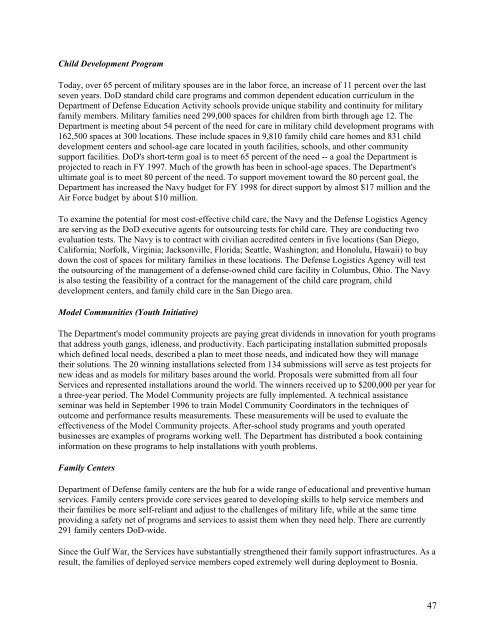
![[PDF] Foulois - Air Force Magazine](https://img.yumpu.com/13391007/1/190x253/pdf-foulois-air-force-magazine.jpg?quality=85)






